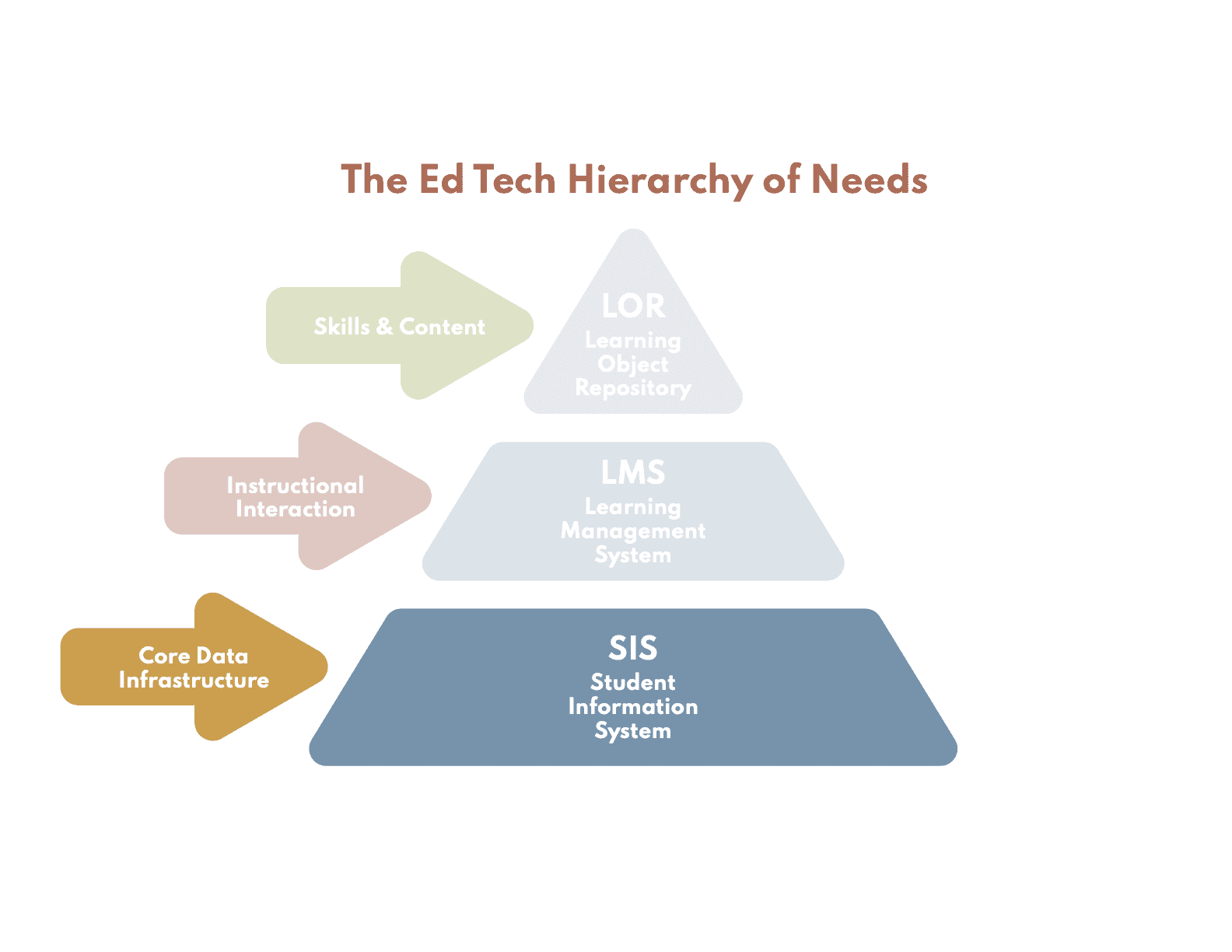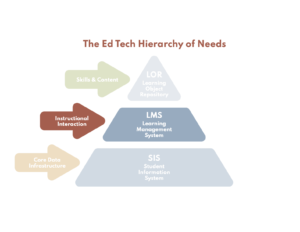Organizing a Modern Edtech Stack for Modern Pedagogy, Part I: The SIS

In both the Instructional Supports Guide and Edtech Leadership Guide, we suggest to edleaders they take advantage of this opportunity for updating not just policies but their technological infrastructure as well. We cover topics in both guides indicating a shift in priorities to a more learner-centered approach is well worth the effort to improve our educational offerings for a more equitable learning environment for all students, regardless of the continued impact of a global pandemic and call to eradicate systemic injustice. For the sake of sustaining such endeavors and see it reflected in the procurement, implementation, and integration of tools to accomplish this mission, we will focus on those enterprise tools that impact most directly the shared vision and mission of most local education agencies in Texas, regardless of size and location.
We’re amidst a paradigm shift the likes of which only hindsight will offer the most definition, but in the present, we know this much: according to the 2020 EdTech Top 40 report from LearnPlatform, an average school district accesses 1,055 edtech applications monthly. The likelihood of that number going down in the coming decade is slim at best. Especially considering the multitude of apps that teachers (and in more cases, students) surface for attending to specific learning opportunities or remediating missed or difficult to attain skills and concepts. Teachers benefit from these market innovations yet for the core stack of applications used by significant portions of the members of a learning community—those that would qualify as “enterprise-grade”—new names and approaches aren’t as prolific or diverse given the form and function restrictions dictated by state compliance and widespread usage demanding universal design across more personas. In short, a different assortment of math, reading or STEM applications can surface every week in a school’s list of apps teachers are using but a student information system (SIS) or learning management system (LMS) shift occurs much more rarely.
Aside from triage-grade changes you and your vendors made in the spring of 2020 to ensure a continuity of learning, if you haven’t evaluated your edtech stack recently, now is the time to do so.
To frame this conversation, we will continue to reference the model of the edtech hierarchy of needs seen in the diagram below:

The safe assumption is that every school or district in Texas is using one of the popular student information systems on the market such as PowerSchool, Skyward, and in some places, Infinite Campus, Alma or even the homegrown TxEIS. There are others in smaller numbers, but SIS, in general, isn’t as volatile as other categories of edtech. These enterprise tools share an overlap of features and regularly update their platforms for compliance issues or as demand increases for supporting emerging trends in teaching and learning.
Depending on the learning model and the needs of the teachers for serving the students in your community, one solution may function more optimally than another. What’s common, just like with cafeteria food, is that enterprise software developers can’t please all users without disappointing others.
Whether you’re satisfied that your SIS is keeping up, we cover five considerations for your vendor as you evaluate performance and how to improve upon things for the remainder of the 2020-2021 school year and beyond, no matter how instruction is delivered.
1: Can you access reporting data easily for local and state reporting?
Because compliance is the highest-stakes function of an SIS and getting it wrong could mean an impact to school funding, this has to be the first topic to address. Teachers may collect the most data the most frequently, but it’s the data coordinator, state reporting manager, or tech department with more responsibility to get this right. A well-designed state reporting toolset in the SIS is essential to keep up with the changing specifications coming out of the statehouse each school year, and it’s this same backend functionality generating reports from the total dataset to inform staffing decisions, intervention efficacy, or even recruiting efforts to boost enrollment. As banal as it may sound, more than any other dataset in your school, the one residing and sustained in your SIS is the source of truth. There are three things to evaluate as look to the quality of your SIS’s reporting functionality:
Data Entry
For all roles in your school, is it easy to enter information as soon you log in and commit to a task? Examples can include parents completing a registration form for a new school year (if applicable), a teacher taking an attendance record, or an administrator logging a discipline note after a referral from the classroom. Can all the different users in your care intuitively know how to access the right part of your system and provide the necessary information accurately? If not, can you determine if the issue is the responsibility of the vendor to design a better user interface or if it’s a professionalism/training issue? Either way, if you can’t gather the right information efficiently and accurately, doing it manually or following up will consume time that could be given elsewhere.
Data Management
When a family moves to a new house in the same district boundaries, is it easy to update that information? Are you able to verify it with real-time comparison to make sure the family is still in-district? What about when a student returning from an illness has to make up work that was logged in a prior grading period? Are your teachers able to modify those grades without requiring an administrator to unlock that finalized term? And when your state reporting coordinator is against a deadline and discovers a building-wide error that needs to be corrected, can she quickly batch update that field across multiple student roles with selectivity? Or will she have to download the file as a CSV and edit it manually in her spreadsheet tool of choice?
The results vary widely from one SIS vendor to another when it comes to robust data management. Some afford excellent control over batch operations internally and others allow for flexibility based on the roles and permissions determined by administrators. Coming to your vendor with a few scenarios that reflect real local and state use cases will show just how much work has been invested in the data management of your vendor’s platform and the implications on your current staff’s aptitude for making changes externally when necessary.
Data Extraction
There’s a local board meeting at the end of the week, and it’s coincidentally on the same day as that one peculiar monthly state report that’s due. The same staffer could be fielding the data needs for both outcomes and based on the two subtopics above, could be a matter of seconds or days, without hyperbole. Most of the dynamic range could be explained in the complexity of the requests, but also in the vendor’s design for exporting data out of the system to the specification demanded by the use case. Either way, the SIS’s reporting functions should have enough sophistication to reduce the amount of manual manipulation of information to preserve the integrity of the dataset, whether for sharing progress with the board or fulfilling reporting expectations from TEA.
2: Does the vendor support data interoperability across your stack (especially the LMS)?
According to the edtech advocate, Project Unicorn, “data interoperability is the seamless, secure, and controlled exchange of data between applications.” As we see in the basic model of the edtech stack above, foundational data either entered or managed in the SIS for certain outcomes may have originated in the learning management system or any other compliant/compatible apps we use in different classrooms, departments, or offices in our districts. Data interoperability promises to recover productivity from each and every position in our schools district-wide. But it has to be an elegant and sturdy ‘integration’ between platforms or apps. Much like with our instructional expectations, there must be adherence to standards and best practices for data interoperability to be successful. Not only does the aforementioned Project Unicorn provide technical assistance and advocacy for your needs, but they do so with the participation of other organizations in our field. A4L, IMS Global Standards, Ed-Fi and a number of third parties are invested in making data interoperability a priority. The end users can create even richer and more secure interoperability across their datasets by speaking up and demanding it as part of their contracts.
Shouldn’t my vendor build the integration?
If you lack the technical prowess in-house and don’t belong to a local consortium for sourcing those tasks, Project Unicorn’s Community Platform offers all educators the opportunity to “Book a Unicorn” and gain a consultant to help navigate the work. More often than not, that’s not required. Yet you may not feel initially like your vendor’s answers are sufficient to map data from app A to app B. If they are resistant or quick to quote a cost to you as dictated by your contract, underlining that ahead of its next renewal could be a negotiating advantage to retaining your school’s loyalty or gaining a new vendor eager to connect your SIS to the other important tools in your stack.
Talking about Integrations
Integrations between two platforms to achieve data interoperability require involvement and access beyond your control as an administrator. That’s a good thing. It keeps the structure of your bi-directional data flow more sound when things change. Knowing how to speak their language helps guide your intuition, even if it feels a bit beyond your purview as a school administrator, so you can frame it as such when you do. But do you know if your SIS vendor has public API (stands for “application programming interface) documentation for other companies to access for building an integration? Or do they rely more on a nightly syncs of data? To be clear, both have their place. But a vendor with API-based integrations is a more modern edtech vendor built on a more flexible and evergreen platform. It also may mean real-time data interoperability, meaning a special education director could make an update to a student’s IEP, and a new accommodation could be instantly available to the teacher in the SIS.
3: Are students and parents able to easily access their student and household data?
This hearkens back to the first question about data entry, but it’s more about providing clear expectations to the families you serve. A common complaint is that parents aren’t sure where to log in depending on the alert or instruction they receive from a school staffer due to the vast quantity of edtech vendors employed by the average school compared to the quality of user experience designed by those same vendors, optimized for each role.
Does your vendor offer a different view of the data based on that role? And are those views the right balance of data presented? Educators staring at reports, visualizations, and other presentations of diverse education data may be accustomed to interpreting the information no different than a pilot of an Airbus 380 consulting the instrument panel during a flight. But parents and students spend inordinate amounts of time sifting through too much information on their way to meeting expectations for school operations let alone academic progress.
If your vendor is going to support student and parent accounts, creating a quality user experience for families is first and foremost their responsibility. Even in how much freedom they give your staff for customizing the page is their responsibility. The irony here is that less is exponentially more. Less information. Less customization. More clarity. So if your vendor touts otherwise, it speaks of how much they value their own information and visual design acumen relative to you and your staff trained in another professional discipline. A good SIS vendor is confident in their screen designs for all roles in the learning community and adjusts with user feedback without sacrificing design principles.
4: Does the transcript feature align to the current state transcript?
For some educators, the transcript is the north star. It’s ultimately the product that reflects your leadership as evidenced by students’ growth and readiness for what comes next. For others, it’s an outdated credential in need of an overhaul. While that debate simmers, in the interim, school leaders need this cumulative credential to be accurate, self-generating, and easily accessible when graduates call back to ask for another copy to be sent in a secure way. Digital credentials have been displacing the notarized transcript of yesteryear but not wholesale. Parchment has the most influence in this space, but data is gathered automatically by way of a secure bit of data interoperability, funneling that student’s updated records into an intermediate database accessible to the postsecondary institution seeking to verify and then admit that student.
Therefore the SIS’s transcript functionality may seem ancillary to day-to-day features, but your ability to pass that data along securely and reliably with each transcript request, let alone augment it for school branding or reflecting accomplishments or salient information not required by the simple state template may be worth revisiting. And for a few years more, the ability to print the transcript in the high school front office on a security paper stock before sealing and sending is a legacy function worth keeping in your requirements if appropriate.
5: Does the grade book align with the one in your LMS, regardless of the grading approach?
This final consideration gives credence to the education sector’s predilection for a standalone LMS to work in conjunction with your foundational SIS. More related topics will be covered in a subsequent post on LMS guidance, but aside from a couple of other factors, alignment of grading policies, grading scales, and grade books can be a crucial decision-making bit of criteria when evaluating your SIS.
Firstly the data interoperability that covers the shift from logistical to instructional is extremely valuable. If your SIS and LMS are built out well, it leads from a student registering for a new school year, being assigned classes by guidance or advisory staffer, and seeing their demographic information reflected in user account provisioning for the LMS and associated third-party instructional apps on the roster for the first day of instruction. Making a simple diagram of that process and sharing it with both your SIS and LMS vendors can start that process on the technical side, which precedes the next level of interdependent details that reflect your philosophy as an edleader, the needs of your students, and the ability to support modern teaching and learning amongst your teaching staff.
What are your grading policies, how is that reflected in your grading scales, and how do teachers enter grades? Semantics aside, a good SIS should be able to support the traditional A-F grading scale or other simple variations on that same theme of flat, tiered relative mastery. But most SIS’s intending to stay relevant and help advance the profession towards best practices should offer support for more granular and specific feedback like we see in mastery- or competency-based approaches.
Does your SIS offer a standards-based grading system? How does it align with that in your LMS? Are the two compatible when uploading banks of learning targets, allow for efficient alignment of standards to instructional activities, and even generate rubrics for sharing with students and parents so they know what the activity will be focused upon?
This is likely the most nascent edge with a number of vendors still trying to catch up in how they visualize progress for a student across time, a teacher across the roster, and the administrator across cohorts or grade levels. Good vendors should show solid progress and adaptability so as to keep students from wondering how they’re doing on specific skills all the way through to earning a credit no matter how it’s awarded.
Summary
SIS vendors offer scads of other niceties to help sweeten the pot, but these core functions are what are underlying and most critical for a data solid foundation and more expansive opportunity to infuse other great tools into the learning experience design. Developing a positive relationship with your SIS vendor account representative and asking for insight into their product roadmap or to be included in one of their advisory panels is something more educators would benefit from, as well. And when you and your team have built consensus around needs using questions and thoughts such as those presented here, you can embark on a migration to a new platform that fits your needs significantly better.
For more, see:
- Closing the Digital Divide for Parents: A COVID-19 Story
- The Two Most Important Things We Don’t Teach
This blog is part of a rich resource set created by Texas Learning Exchange (TxLx), a project Getting Smart is working on in partnership with Altitude Learning and Getting Smart. To learn more about TxLx or access resources for school and district leaders, educators, and district teams visit TxLx.org
Stay in-the-know with innovations in learning by signing up for the weekly Smart Update. This post includes mentions of a Getting Smart partner. For a full list of partners, affiliate organizations, and all other disclosures, please see our Partner page.





0 Comments
Leave a Comment
Your email address will not be published. All fields are required.